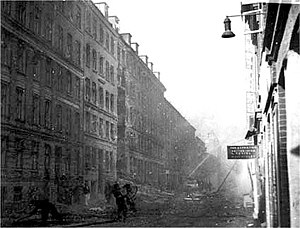Operation Carthage
| Operation Carthage | |||||||
|---|---|---|---|---|---|---|---|
| Part of World War II | |||||||
 The air raid on the Shellhus |
|||||||
|
|||||||
| Belligerents | |||||||
|
|
|
||||||
| Strength | |||||||
| 20 bombers, 30 fighters | Various antiaircraft defences | ||||||
| Casualties and losses | |||||||
| 6 aircraft destroyed 9 aircrew killed 1 aircrew captured |
The Danish headquarters of the Gestapo destroyed 55 German soldiers and 47 Danish employees of the Gestapo killed |
||||||
| 125 Danish civilians killed, including 86 schoolchildren 8 Danish prisoners of the Gestapo killed |
|||||||
Operation Carthage, on 21 March 1945, was a British World War II air raid on Copenhagen, Denmark, which incurred significant collateral damage. The target of the raid was the Shellhus, used as Gestapo headquarters in the city centre. It was used for the storage of dossiers and the torture of Danish citizens during interrogations. The Danish Resistance had long asked the British to conduct a raid against this site. As a result, the building was destroyed, 18 prisoners were freed, and anti-resistance Nazi activities were disrupted. But, part of the raid was mistakenly directed against a nearby boarding school; it resulted in a total of 125 civilian deaths (including 86 schoolchildren and 18 adults at the school). A similar raid against the Gestapo headquarters in Aarhus, on 31 October 1944, had been successful.
The raid was requested by members of the Danish resistance movement in the hope of freeing imprisoned members, and destroying the records of the Gestapo to disrupt their operations. The RAF initially turned down the request as too risky, due to the location in a crowded city centre and the need for low-level bombing, but they approved the raid in early 1945 after repeated requests.
Once approval had been given, planning for the raid took several weeks. This included making scale models of the target building and the surrounding city, for use by pilots and gunners in preparation for a very low-level attack.
The attacking force consisted of Royal Air Force de Havilland Mosquito F.B.VI fighter-bombers of No. 21 Squadron RAF, No. 464 Squadron RAAF, and No. 487 Squadron RNZAF, from the No. 140 Wing RAF. These were organised in three waves of six aircraft, with two reconnaissance Mosquito B.IVs from the Royal Air Force Film Production Unit to record the results of the attack. Thirty RAF North American Mustang fighters gave air cover from German aircraft, and these also attacked anti-aircraft guns during the raid.
...
Wikipedia
